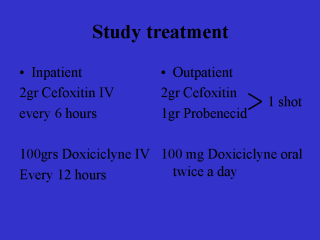 |
We randomized these women to
either inpatient or outpatient therapy. This was a fairly expensive study. You may note
that the antibiotics on the inpatient side, Cefoxitin and Doxiciclyne, are exactly the
same as the antibiotics on the outpatient side. I would point out, then, that the point of
the study was to compare strategies of treatment, so the inpatient strategy was actually
about ten times more expensive than the outpatient strategy. The inpatient strategy
includes 48-72 hours of inpatient antibiotics given intravenously, and the outpatients
strategy includes a shot of antibiotics and a container of Doxiciclyne to take home. Since
we were comparing strategies and not antibiotics, it made sense to look at the same
antibiotics in those two conditions. In fact, given intravenously, we do know that serum
levels for these antibiotics are clearly higher, and in addition, compliance is assured,
while it certainly is not on the outpatient side. One of the things we did was look
specifically at patient compliance, since we knew that was the major question, and in a
subset of the diseased patients, we gave them what are called MEMS caps, computerized caps
that monitor every time the jar is opened. |
